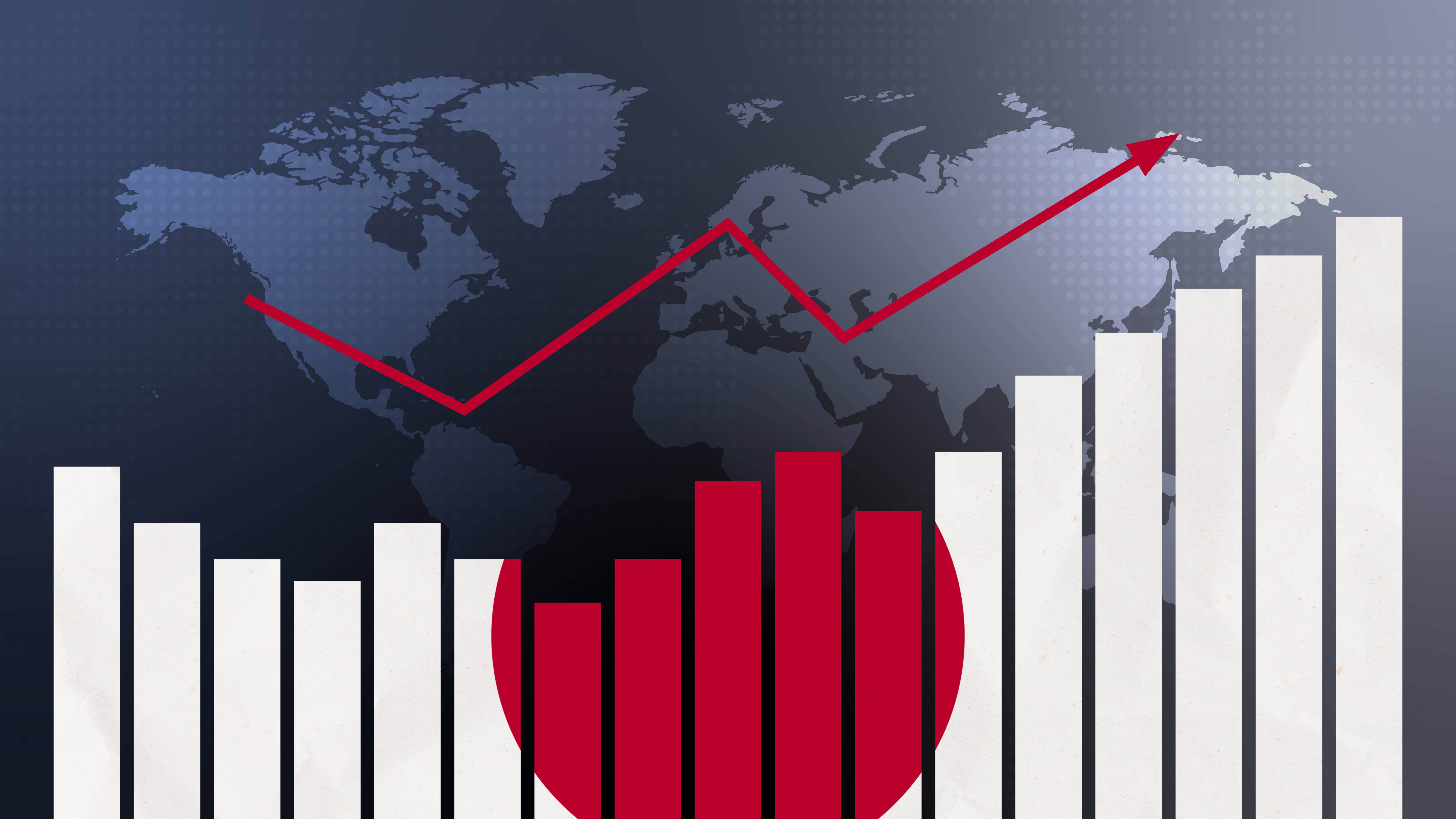
- Article
- Macroeconomics, Economic Policy
Japan’s Potential Growth Rate and the Post-Pandemic Outlook
August 19, 2020
The Japanese economy has rebounded quickly from the initial “coronavirus shock,” but can it sustain that momentum? Economist Hideo Hayakawa offers a sobering prognosis centered on Japan’s flagging potential growth rate.
* * *
The Japanese economy appears to have bottomed out in May 2020, raising hopes for a quick and relatively painless recovery. But such a rosy scenario ignores the realities of the COVID-19 shock and the structural sluggishness of the Japanese economy.
On the Upswing
Early in the spring of this year, social distancing directives triggered a sharp economic downturn, as businesses shut their doors or curtailed their hours and citizens heeded government calls to stay at home. The Bank of Japan’s monthly Consumption Activity Index (travel balance adjusted) fell by 6.8% in March and plunged another 9.3% in April. Then, with the government phasing out the state of emergency, consumption picked up again, rising 1.3% in May. June saw a pronounced rebound as further reopening—along with the government’s ¥100,000 individual stimulus payments—released pent-up demand.
In terms of exports and manufacturing output, the trend has been similar, albeit a bit delayed, reflecting the evolving situation overseas. In the manufacturing sector, monthly output fell 9.8% in April and 8.9% in May, but the slide halted in June, and production now appears to be on the upswing.
In the July ESP Forecast (compiled by the Japan Center for Economic Research), Japan’s forecasters predicted –23.5% annualized growth in gross domestic product for the April–June quarter of 2020 but a jump of 9.4% for the July–September quarter. If this outlook proves correct, it will mean that the economy bottomed out in May 2020, roughly a year and a half after the peak of the “Abenomics” expansion. This would make the latest downturn on a par with the average cyclical contraction (about a year and a half).[1]
Unfortunately, it seems doubtful that the momentum will continue and yield the “V-shaped recovery” optimistically predicted early on. More likely, the growth spurt will lose momentum after the initial rebound fueled by pent-up demand.
Slow Recovery Foreseen
There are a number of factors militating against a V-shaped recovery. One is joblessness. It is true that Japan’s official unemployment rate barely rose in response to the slowdown attending the pandemic, but that was only because the vast majority of those who were idled were technically on furlough and therefore not classified as unemployed.[2] But a substantial number of those who were furloughed will not be called back to work, and they will eventually be reclassified as unemployed. Wage levels are also headed downward, judging from the level of this year’s summer bonuses.
In terms of capital investment, the results of the Bank of Japan’s Tankan survey (Short-Term Economic Survey of Enterprises in Japan) would suggest that the contraction will be less severe than that seen during the Great Recession, but some downward adjustment is inevitable.
An even bigger potential obstacle to a V-shaped recovery is the coronavirus itself. The inability of the United States and many emerging economies to bring the epidemic under control bodes ill for a swift global recovery. And the recent surge of cases in Japan’s major metropolitan areas is bound to put a damper on domestic consumption, even if it does not lead to another state of emergency.
It is partly owing to these constraints that the ESP Forecast’s consensus outlook for annualized GDP in the January–March 2022 quarter (the last period covered by the survey) is still some 3% below the pre-coronavirus peak of July–September 2019 (prior to the contraction triggered by the October 2019 consumption tax increase)—and this despite the fact that almost none of the forecasters were anticipating a second wave of infection. At this rate, a return to pre-crisis GDP levels is unlikely before the spring of 2023.
Potential Growth on the Decline
Some might question why it should take so long to recover from the effects of a transient negative demand shock. But we should keep in mind that it took Japan five years to make up the ground it lost in the Great Recession. At the heart of the problem is the flagging potential growth rate of the Japanese economy.
Prime Minister Shinzo Abe’s expansionary economic program, known as Abenomics, had the benefit of one of the longest expansions of the postwar period. Unemployment in Japan fell below 2.5%, the lowest rate since the early 1990s (just before the collapse of the “bubble economy”). Yet even before the pandemic struck, annual GDP growth was averaging less than 1%—which is probably why the expansion did not feel like much of one. And even in the midst of such modest growth, industry has been plagued by labor shortages. This situation testifies to the Japanese economy’s low growth potential (and, some might say, to the inadequacy of the growth strategy that constitutes the “third arrow” of Abenomics).
The potential growth rate is defined as the annual change in the potential GDP—the highest aggregate output of goods and services a country can sustain over the medium term using the factors of production at its disposal. This makes it sound simple, but estimating potential growth rate is actually quite tricky. The basic approach is to begin by calculating total factor productivity (TFP) using the relationship
∆Y = ∆TFP + α∆L + (1 – α) ∆K
where Y is real GDP, L is labor input and K is capital input (a is labor share).[3] Next, data smoothing is used to derive the TFP growth trend. Then medium-term growth in labor and capital inputs is factored to arrive at the potential growth rate.
The problem is that to produce a valid estimate, it is necessary to exclude the effects of cyclical and other short-term fluctuations. In Japan this is particularly problematical because employment is very slow to adjust to cyclical downturns (owing to the practice of “labor hoarding”). The result is that during contractions, the standard methods of calculation will yield a big drop in TFP, which will cause the estimated potential growth rate to fall as well.
The Cabinet Office and the Bank of Japan both periodically release their own estimates of Japan’s potential growth rate. The Cabinet Office’s most recent estimate is 0.9%, while the BOJ’s is just 0.13%.[4] This yawning gap doubtless reflects issues on both sides: The BOJ’s calculation was unduly influenced by the recent downturn, while the Cabinet Office has been too slow to revise its estimate. My own feeling is that a fair calculation excluding short-term cyclical factors would yield a potential growth rate of around 0.5% or slightly higher.
Be that as it may, there is no question that Japan’s potential growth rate has fallen sharply since the 1980s—from over 4% to less than 1% today. This loss of core strength has contributed to the economy’s persistent stagnation in the decades since the collapse of the bubble, and it makes a slow recovery from the coronavirus recession all but inevitable.
The Pandemic’s Effect on Potential Growth
The next question is whether the long-term fallout from the COVID-19 crisis might actually erode Japan’s potential growth rate further. There are several reasons to fear such an outcome.
The first relates to productivity. Social-distancing measures adopted to slow the spread of the coronavirus—including limits on the seating capacity of drinking and dining establishments—will depress productivity in many businesses providing in-person services. They could also affect retail businesses by limiting their ability to attract crowds to sales and other events. To be sure, it should be possible to lift many of the constraints once we have effective vaccines and therapies, but in some cases the effects of the COVID productivity shock will be irreversible.
Productivity in the manufacturing sector is likely to take a hit as well, as Japanese companies rethink their supply chains in view of the disruption caused by the pandemic, as well as the escalating trade war between the United States and China. After the Cold War, manufacturers began sourcing and producing offshore to take advantage of cheap labor and other cost factors. The development of these international supply and production networks nourished the expansion of trade and boosted productivity in the manufacturing sector. If the process is reversed, the productivity of Japanese manufacturing is bound to suffer.
A second concern is that the COVID-19 crisis will exacerbate the tendency of Japanese businesses to sit on surplus cash instead of funneling it back into the economy through wage increases and capital investment. A couple years ago, this habit came under harsh scrutiny as political leaders griped about the limited effects of Abe’s bold expansionary policies, and investors complained about the low return on invested capital. But bitter experience has taught Japanese corporations the importance of having cash on hand to tide them over the kind of system-wide credit crunch that occurred during the financial crisis of the late 1990s and again in 2008–9.[5] It would hardly be surprising if the COVID-19 crisis reinforced this proclivity for hoarding cash. That would inhibit capital accumulation and push down Japan’s potential growth rate.
A third concern is the long-term effects of government relief programs, such as unsecured, interest-free loans and the employment adjustment subsidy. In the short run, such measures are necessary to prevent the collapse of fundamentally sound businesses owing to a temporary cash shortage. By preventing the dispersal of managerial and human resources, such assistance can also make a long-term contribution to the potential growth rate.
However, if relief programs continue longer than necessary, they can have the opposite effect, depressing potential growth by propping up “zombie companies” that were struggling even before the crisis.[6] The lesson is that emergency relief programs need to be terminated in a timely fashion. Unfortunately, political pressures often make that difficult, as we discovered in the aftermath of the Great Recession. (For example, a moratorium on loan repayments by small businesses and homeowners was extended twice.)
Fourth, we may also have to factor in the effect of school closures on the education of our labor force. Given the substantial loss of classroom time at the primary and secondary levels—which are regarded as being Japan’s strengths—the long-term effect on labor productivity is something to watch for, especially when one considers the growing importance of intangible assets to economic growth, as discussed below.
To one degree or another all the above-mentioned factors will affect countries around the world, not just Japan. (The restructuring of supply chains, for example, could seriously blunt the dynamism of certain emerging and developing countries.) The Great Recession is said to have depressed the potential growth rate globally, and a further slide in the wake of the COVID-19 crisis could raise the specter of global “secular stagnation.” In Europe, some have used the term “Japanification” to warn of a descent into chronic sluggishness amid rock-bottom interest rates.
Investing in Digitization and Intangibles
That said, there are some grounds for optimism as well. Japan has an opportunity to ratchet up its growth potential by actively pursuing digital transformation and investment in intangible assets.
The recent state of emergency threw into high relief Japan’s failure to keep pace with the rest of the developed world in the use of digital technology for such purposes as telework, teleconferencing, remote learning, digitization of healthcare, and e-government. Many of us were shocked to learn that faxes were being used to transmit case statistics, and municipalities were processing applications for emergency cash benefits by hand (even after they had been submitted online). The public and private sectors need to join forces to promote digital transformation and prevent further erosion of Japan’s growth potential.
Now that the pandemic has clearly illustrated the need for teleworking and remote learning, some targeted subsidies and incentives may be sufficient to get the ball rolling. But in areas where resistance to change is strong, such as digital healthcare and e-government, the central government needs to provide a stronger push.
Recent economic research has highlighted the critical role investment in intangible assets plays in fueling productivity gains. In its calculation of GDP, the government already includes investment in software and research and development under the category of capital investment, but more emphasis needs to be placed on investment in such intangibles as brand value, knowledge and human capital (through education and training), and organizational capacity (including the ability to capitalize on R&D gains). A number of recent studies have linked Japan’s flagging potential growth rate to inadequate investment in intangible assets, along with the lag in digital transformation.[7] Japanese industry must become more proactive and creative in its utilization of intangible assets if Japan is to reverse its long-term economic decline.
[1] By way of comparison, the Japanese economy took half a year to bottom out after the bankruptcy of Lehman Brothers in September 2008, having peaked the previous February.
[2] In this respect, Japan differs from the United States, which counts furloughed workers as unemployed. The US unemployment rate soared in April but then fell more than expected in May, probably thanks to the call back of laid-off employees.
[3] Because TFP is measured by subtracting the effects of labor and capital inputs from GDP growth, it is sometimes said that “TFP is nothing but a residual.” However, a rewriting of the equation reveals that TFP is the weighted average of labor productivity and capital productivity, which is an apt expression of a country’s macroeconomic productivity.
[4] For the Cabinet Office’s estimates, see www5.cao.go.jp/keizai3/getsurei/getsurei-index.html; for the Bank of Japan’s, see www.boj.or.jp/research/research_data/gap/index.htm/. Another reason for the gap between the two is that the impact of recent changes in the labor market, such as the rise in labor-force participation among seniors and women and the drop in hours worked (partly as a result of the government’s “work-style reform” initiative), depends on whether they are viewed as fluctuations or trends.
[5] For a discussion of “learned pessimism” as a characteristic of Japanese corporate behavior, see Hideo Hayakawa, Kin’yu seisaku no “gokai” (Monetary Policy Misunderstood) (Keio University Press, 2016), chapter 4.
[6] See Ricardo Caballero et al., “Zombie Lending and Depressed Restructuring in Japan,” American Economic Review, vol. 98, no. 5 (December 2008), www.aeaweb.org/articles?id=10.1257/aer.98.5.1943. The tendency of unproductive firms to linger instead of being eliminated through competition with more productive rivals has been cited as one of the factors depressing overall productivity and economic growth in Japan. See, for example, Kyoji Fukao, Ushinawareta 20-nen to Nihon keizai (The Japanese Economy and the Lost Two Decades) (Nikkei Publishing, 2012).
[7] See Tsutomu Miyagawa et al., Intanjiburuzu ekonomi (Intangibles Economy) (University of Tokyo Press, 2016); Toru Morotomi, Shihonshugi no atarashii katachi (The New Shape of Capitalism) (Iwanami Shoten, 2020); and Jonathan Haskel and Stian Westlake, Capitalism Without Capital: The Rise of the Intangible Economy (Princeton University Press, 2017).








